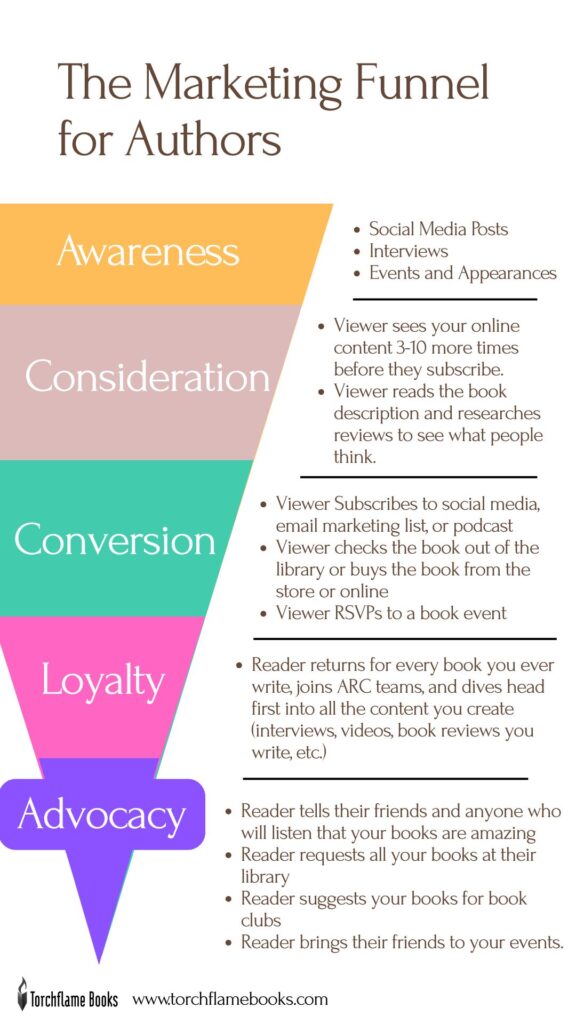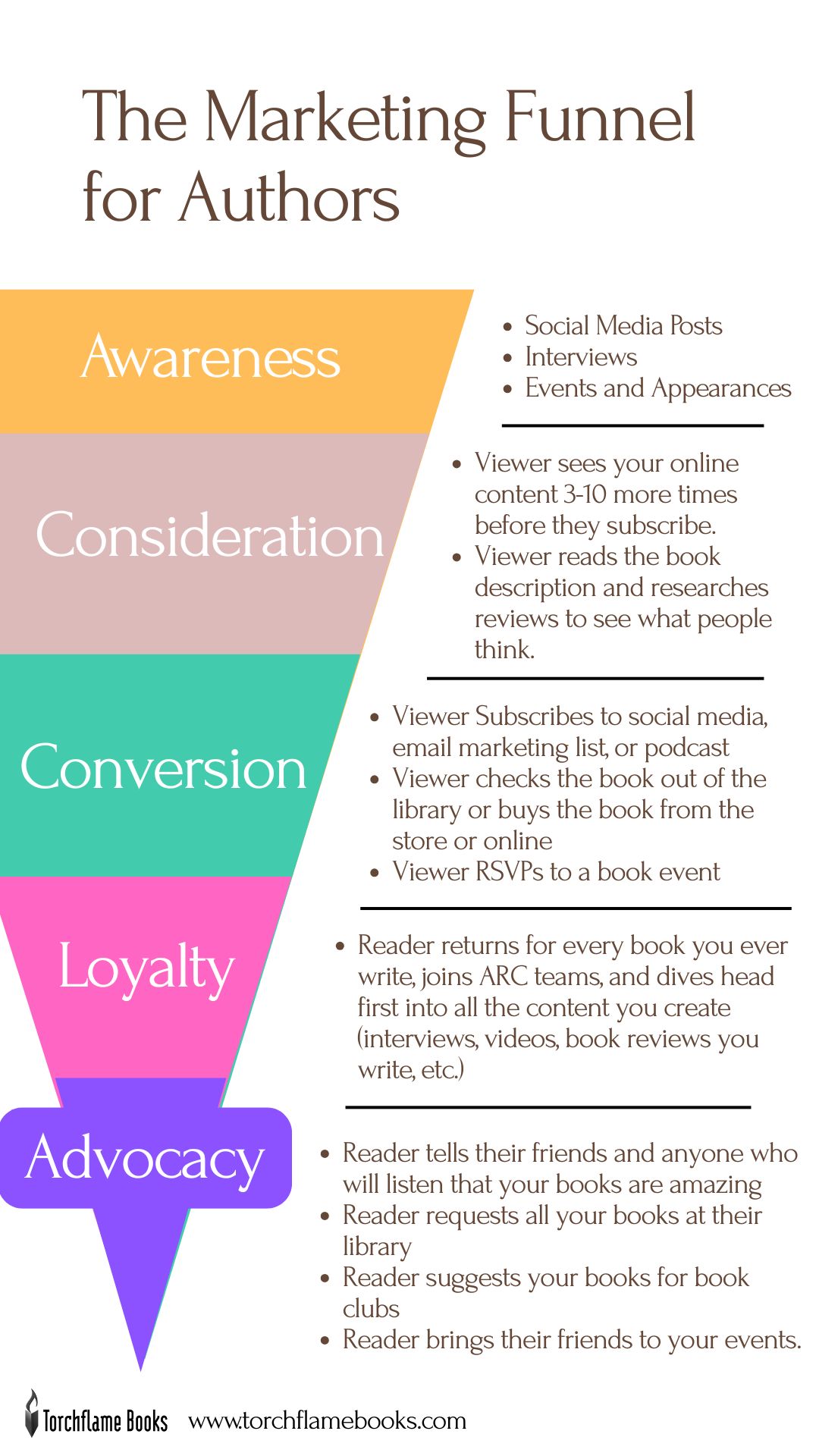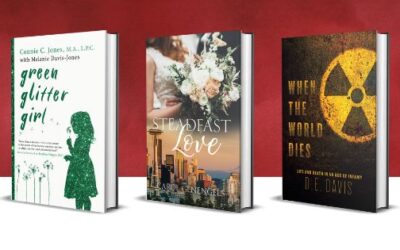By Jori Hanna
Today we want to talk about one of the most effective online marketing techniques you have access to for free—an email newsletter.
Before your eyes glaze over as you think about how many emails you delete without opening in your own inbox, hear us out. When it comes to book marketing, there are only a few options at your disposal. These options come down to Friends and Family, Strangers in Person, and Strangers Online.
Every piece of marketing you will ever do will be focused on one (or more) of these three groups, so it’s vital that you learn how to expand and combine these groups to funnel them into a new segment—strangers who are interested.
This is the power of email marketing: to take strangers, pique their interest, and give them information they can act on.
Introduction to the Marketing Funnel
Just in case you’ve never heard of this before, this is what marketing gurus call “The Marketing Funnel.” This funnel takes “cold contacts”—people who don’t know your name, what you do, or what you write—and moves them down a system that “warms them up” until they are ready to buy, invest, or support some other way. It will take the average person 30+ positive interactions with you or your content before they recognize you (the awareness phase), and another 7 before they are willing to financially invest (the conversion phase). Your social media, your website, and your email list are all increasing the probability that you can funnel that one person through all of those required interactions.
At the top of the funnel you have your cold contacts who have no idea who you are (Awareness). At the middle of the funnel are readers who may have read one book by you, or may follow you on social media, but aren’t super invested (Considering). At the bottom of the funnel are your top fans who will talk about your books evangelistically and buy every book you write on sight, no questions asked (what Sprout Social refers to as Loyalty and Advocacy).
Note: Please don’t get overwhelmed by the idea of sharing personal details on a constant basis through a newsletter. Most people find it easier to send out news or talk about what’s going on in their lives, but you don’t have to do this at all. You can invite people to “Sign Up for Updates” and those updates can be “My book landed an ebook deal” or “I have a new book coming out in a month” and can be sent out as frequently or infrequently as you can maintain comfortably. The goal is to give you personal access to them, but you shouldn’t overuse this (people will unsubscribe) and you shouldn’t burn yourself out, because a tool is only as useful as the frequency it can be used. More on that in a bit.
The Customer Journey—or How a Reader Discovers New Books
Before we can explore how and why email marketing is beneficial for the marketing funnel, we need to understand how readers typically discover books.
Let’s look at an imaginary example using the ideal reader: Luisa
Luisa, our brilliant, lovely, imaginary online stranger, loves to read mysteries and thrillers. She has a long list of recommendations from her friends, but she’s not interested in any of those books right now. Instead, she logs onto Goodreads, heads over to Listopia, and finds a list of mysteries and thrillers that have been voted on by Goodreads users and curated by their interests.
Ground Truth by Rebecca A. Miles is on that list, and the premise intrigues her. So she searches the book on Barnes and Noble, places the order, and devours this mystery in two days. She loved the book, loved the characters, and wants to know when there will be more from this author. So she heads to Google, finds Rebecca’s website, clicks through to find out the Pittsburgh Murder Mysteries are in development and book two will be coming out in the near future.
Luisa knows from past negative experiences that Facebook or other social media isn’t the most dependable source of information, and she knows she might miss the posts if the algorithm doesn’t send them to her. (This has frustrated her in the past because she missed Harlan Coben’s most recent release and was behind the times and didn’t get to preorder it.) She clicks through the Rebecca’s to the contact page, sees there’s a signup form that’s really simple—all it’s asking for is her name and her email—so she can get an email when book two comes out.
Luisa, having learned from her mistake with Harlan Coben (don’t worry, she fixed her mistake there too by signing up for his email list), signs up, checks her email to make sure everything worked properly by looking for that very simple welcome email, and then heads back to Goodreads to talk about how much she loved Ground Truth and find other similar books to keep reading.
Now, if Rebecca never sends out an email, Luisa may miss her next release. Luisa doesn’t want to miss that release. Luisa is decidedly excited about this series, and she wants to be on top of it. But there are so many books out there, so many authors out there, that by the time book two releases, Luisa may forget it was even coming out.
However, if Rebecca sends out one email, one month before release day, with a cover reveal and a preorder invitation, Luisa gets the information she was interested in and Rebecca almost certainly makes a sale.
The ordered list of ways in which readers discover new books is (typically) as follows:
- They ask a friend if they’ve read anything good recently, and then read that book.
- Their friend tells them what they’ve been reading and suggests they would enjoy it without prompting.
- They wander through a physical store or library and pick up books, reading the back cover until something captures them.
- Their social media feeds are full of people talking about the books they enjoyed and they think, “That sounds interesting!”
- After reading one book from a new-to-them author, they go back for more. (This is why your next books always sell your previous books—readers are often extremely loyal to the authors they enjoy.)
Remember, Luisa is our ideal reader. She is actively seeking new books by authors she hasn’t read before and she wants to read something her friends haven’t vetted for her.
Luisa, still interested in mysteries and thrillers, ends up on the Torchflame Books website while she’s looking for Rebecca’s website and finds Nancy Boyarsky’s Nicole Graves series. There are currently eight books in the Nicole Graves series, and Luisa is simultaneously excited that she has so much reading material and overwhelmed—where does she start? Should she buy all those books?
She starts with The Swap, since it’s the first in the series, decides she likes this series as well, and subscribes to Nancy Boyarsky’s email list through the same process she went through for Rebecca.
That month, it just so happens that Liar Liar, number three in the Nicole Graves series, is on sale for $0.99, so Nancy sends out an email to let her followers know they can take advantage of an ebook deal. Luisa gets this email, and even though it’s not the next book in the series, she knows she wants to buy them all. She figures she may as well collect them out of order, since this one is on sale.
It’s possible that Luisa may have found out about this sale just by scrolling social media or by searching for the Nicole Graves series at the right moment, but she chose to be in the know about Nancy Boyarsky’s news, and she wants those details and that information.
Your author newsletter does a favor for your readers.
The larger your reader base grows, the more important this list will be. The best news is that you can get started with this completely free through a company like Brevo, and there are tons of templates you can use wherever you choose to send emails from (Brevo is only one option. Many people also choose to use Constant Contact, Mailchimp, Mailerlite, etc.) that will make your emails beautiful and effective from day one.
If you notice in that example, neither Nancy nor Rebecca had to do anything more than create the sign-up form and send out the marketing blast they were planning to send whether or not Luisa was subscribed.
Your reach can increase without any additional effort on your part once the system is set up. It is the kind of automated marketing that can happen in the background while you focus on writing–assuming you spend the time to set it up well, and have invested in other elements of your online discoverability. At Torchflame Books we work hard to ensure readers can find and connect with our authors to boost our authors to the top of online search results.
In a best-case scenario, the 30-60 minutes you spend setting up and editing your website to make it accessible for your readers results in a vibrant and lively list of actively interested readers that can grow on its own. In a worst-case scenario, you get to send an update to fifteen readers who are extremely interested in hearing from you. Those fifteen readers some of the most dedicated and loyal readers you can have, who will likely engage in word of mouth marketing on your behalf, request your book in their local library system, and review your book online. That’s fifteen reviews you may not have gotten any other way.
Now, let’s look at the funnel. We’ll model our funnel off of the funnel categories recommended by Sprout Social.
 This funnel applies to any way a reader may discover your book. But it’s important to remember that discovering a book is a top of funnel (Awareness) entry point. In book marketing, we focus most of our effort here because the book is packaged to lead people through the rest of the funnel more or less independently.
This funnel applies to any way a reader may discover your book. But it’s important to remember that discovering a book is a top of funnel (Awareness) entry point. In book marketing, we focus most of our effort here because the book is packaged to lead people through the rest of the funnel more or less independently.
But if a reader enters the funnel from your social media, you will inevitably need to guide them through the rest of the funnel yourself. This funnel applies to every type of marketing. Usually, the “conversion” activity is purchasing the book. But sometimes conversion is landing a subscriber or a new review. Sometimes a conversion is getting people to come to your event.Try your best not to think of conversions only as a financial gain for you.
How do you use the marketing funnel for an email list?
This dives into how you grow your audience. The conversion here is that someone subscribes to your email list.
Awareness
Your potential followers need to know that your email list exists, and they need to have a reason to subscribe. Much like reading the back of the book to figure out why they should read that particular book, they need a summary of what you offer in your emails. The best way to do this will be to set up the necessary forms you need on your website, and then approach any contacts you already have and send them to your website to subscribe. It may also benefit you to create an email lead magnet to attract people to your list and your content.
Consideration
Now that you have the technology set up to collect emails, create a landing page that gives your audience examples of what they can expect (this may be a sample newsletter) and a summary of the type of content you share.
Additionally, declare the schedule they can expect content from you. Do you plan on sending an email every day? Does your schedule fluctuate with releases? Do you plan to email monthly? Weekly? Quarterly? Make your decision and then let people know. This will help you weed out the ideal contacts from the contacts who aren’t a good fit for you.
Conversion
If your landing page is doing its job, your list should be growing semi consistently because people are subscribing. If your list is not growing, you may need to revisit the earlier parts of the funnel—are enough people discovering you? How often are they interacting with you after they discover you? How can you improve either of those parts to warm those contacts up to you and make them more likely to convert?
Once they have converted, are they getting what they signed up for? Are you maintaining your end of the agreement by sending them the updates they wanted? Are you engaging with them online?
The entire marketing funnel is essentially relationship building. If you are not successfully selling books, you may need to build a better relationship with your audience (or build a relationship to begin with). This is the heart of marketing: seeing your audience and meeting their needs. If you do that consistently, your audience will be loyal to you because you meet their needs better than the others on the market.

